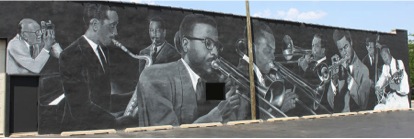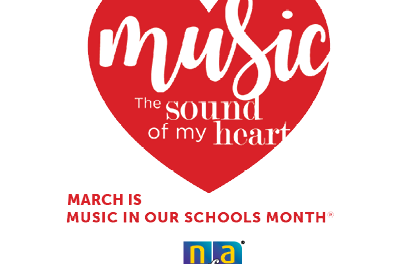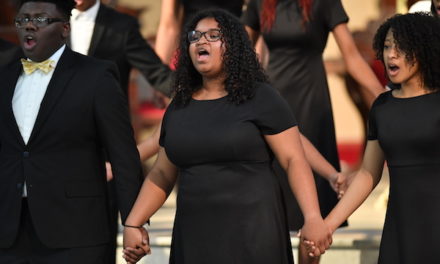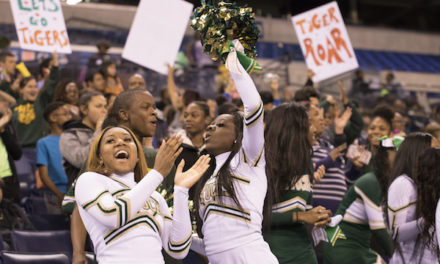April is Jazz Appreciation Month and the very last day, April 30, is International Jazz Day with cities all over the world hosting special events. One of them will be a celebration of David Leander Williams’ new book “Indiana Jazz: The Masters, Legends, and Legacy of Indiana Avenue” with book signing and music by Indiana Jazz Legacy artists Clifford Ratliff and Hank Hankerson accompanied by Monika Herzig at Topo’s 403 in Bloomington. The event is produced by Jazz from Bloomington with support by the Jazz Education Network.
Indiana holds a special place in the history of Jazz in America. We asked Indiana University Lecturer and author of “David Baker – A Legacy in Music,” Monika Herzig to share her knowledge of Indy’s Jazz roots.

Except for the historic Walker Theatre just north of downtown there seems to be nothing unique about Indiana Avenue these days and especially no jazz venues that are worth dedicating a book to. The legend of Indiana Avenue dates back to the Jazz Age when musicians would embark on the Chitlin circuit, a network of venues in towns around the Midwest and South featuring safe engagements for black touring groups during segregation. The central geographic location of Indianapolis at the crossroads of America made it a favorite touring stop and clubs and dance halls blossomed up and down the Avenue. . Known as “Funky Broadway,” “The Yellow Brick Road,” and “The Grand Ol’ Street,” black business was thriving during the heydays of segregation in the 1930s and 40s in the blocks around the Madam Walker Theater. There was jazz six nights a week in more than 30 clubs lining the Avenue, and great touring bands such as Count Basie and Duke Ellington could be heard regularly at the Sunset Terrace.
In addition, Crispus Attucks High School was established in an effort by the Indianapolis population to segregate the school system. It turned out that bad intentions turned into great results. Here is an excerpt from Lissa May’s chapter in David Baker – A Legacy in Music (IU Press, 2011):
The attitude of excellence that permeated the school was exemplified by the music department. Instrumental music teachers LaVerne Newsome, Norman Merrifield, and Russell W. Brown were outstanding musicians, trained at some of the finest music schools in the country. LaVerne Newsome, a graduate of Northwestern University, taught orchestra, string classes, and music appreciation and was known for his dedication to his students. Merrifield, chairman of the Attucks music department, was a pianist, choral director, band director, composer and arranger. He held bachelor’s and master’s degrees in music education from Northwestern University. The music department thrived under his leadership, embodying the values of post-Reconstruction black American life which blended African heritage with European art music.
The result of this nurturing environment and the nightly exposure to great music was a crop of young jazz musicians that excelled at their craft and was essential at codifying the language of jazz. Trombonist J.J. Johnson is acknowledged as the most virtuous and prolific jazz trombonists in history. Guitarist West Montgomery created a new style of playing using his thumb to mute strings and his Riverside Recordings have become models for jazz guitarists around the world. Trumpeter Freddie Hubbard became known for his high-energy approach to ensemble playing and his modern jazz songs became standard repertoire for every aspiring jazz musician. Trombonist Slide Hampton was the youngest member of the Hampton family, a family band of 12 siblings that toured for years before settling in Indianapolis and becoming mentors to the music community. Bassists Larry Ridley and Leroy Vinegar left for New York and played with most prominent musicians at the time. And David Baker’s combo including David Young, Al Kiger, Joe Hunt, and Chuck Israels, a regular feature at the Topper, was recruited by composer/ theorist George Russell for a string of legendary recordings on Riverside Records. The list goes on with many more notable musicians – a wonderful mural picturing several of them can be found now in Indianapolis at 332 N College.

The lesson to be learned is that a nurturing community and exposure to excellence has tremendous impact on young learners. Especially during the month of April, let’s celebrate our regional legacies and jazz heroes. And throughout the year, let’s create a community of support and role models to foster excellence in our next generation.
 Monika Herzig teaches classes on the Music Industry, Creativity, Programming, and Community Arts Organizations at Indiana University. She is the co-founder of Jazz from Bloomington, a jazz society fostering exposure and education about Jazz, and currently serves on the board of the Jazz Education Network, the largest international jazz organization. Her jazz record label ACME Records is home to the jazz ensembles Monika Herzig Acoustic Project, Kwyjibo, Third Man, and BeebleBrox. Herzig received a B.A. from Paedagogische Hochschule Weingarten, Germany in 1988, an M.A. from the University of Alabama in 1991, and a D.M.E. from Indiana University in 1997.
Monika Herzig teaches classes on the Music Industry, Creativity, Programming, and Community Arts Organizations at Indiana University. She is the co-founder of Jazz from Bloomington, a jazz society fostering exposure and education about Jazz, and currently serves on the board of the Jazz Education Network, the largest international jazz organization. Her jazz record label ACME Records is home to the jazz ensembles Monika Herzig Acoustic Project, Kwyjibo, Third Man, and BeebleBrox. Herzig received a B.A. from Paedagogische Hochschule Weingarten, Germany in 1988, an M.A. from the University of Alabama in 1991, and a D.M.E. from Indiana University in 1997.
For more information on the Jazz Band Division of the Music for All Summer Symposium, presented by Yamaha, please visit https://musicforall.org/what-we-do/summer-camp/students/jazz-band.



